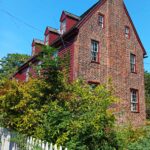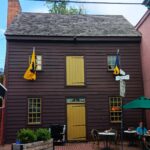Well, we are finally settling into the new house and able to do more exploring of our new area. Over the summer, I wrote a few posts, mostly about exploring  close to home, even in your own backyard. While I love to travel, I also believe you don’t need to go very far to find fun and interesting places. Before we moved to Germany, Dave and I were involved with the 7th Virginia Regiment of the Continental Line, re-creating moments in the American Revolutionary War. When we discovered the 1st Maryland would be “recruiting” in Annapolis over the weekend, we decided to check it out.
close to home, even in your own backyard. While I love to travel, I also believe you don’t need to go very far to find fun and interesting places. Before we moved to Germany, Dave and I were involved with the 7th Virginia Regiment of the Continental Line, re-creating moments in the American Revolutionary War. When we discovered the 1st Maryland would be “recruiting” in Annapolis over the weekend, we decided to check it out.
The Colony of Maryland was founded in 1634, and St. Mary’s City served as its capital for sixty years. Sitting in the very southern tip of the colony, the town’s location proved too far away for adequate representation for the citizens as the colony’s population grew. In 1694, the General Assembly designated the town of Anne Arundel as the new capital. Situated midway up the Chesapeake Bay, it was ideally situated to govern the needs of the colonists. After the death of Queen Mary II, the town was renamed Annapolis in 1695 in honor of her sister, Princess Anne.
Annapolis is only an hour away, so we grabbed the dog and headed north. Pinkney Street is a quaint 18th-century lane, complete with a tavern, the Hogshead. I think I photographed each house as we meandered down the road, eventually finding members of the 1st Maryland who were eager to sign up new recruits.
The 1st Maryland Regiment was well on its way to New York when Thomas Stone burst into the capital in Annapolis on 15 August  1776, fresh from the Continental Congress in Philadelphia. He reported a major battle was brewing in New York City. He claimed, “…by the last accounts they [the British] were shipping their men and making all necessary preparations for an attack.” Fortunately, two rifle companies assembled in Frederick were already on their way under the command of Captains Michael Cresap and Thomas Price. (Note: Those who have read Death on the Line may recognize the Cresap name, as Captain Michael’s father was none other than Thomas Cresap, who fought against the Pennsylvania tax man, claiming his land was in Maryland.)
1776, fresh from the Continental Congress in Philadelphia. He reported a major battle was brewing in New York City. He claimed, “…by the last accounts they [the British] were shipping their men and making all necessary preparations for an attack.” Fortunately, two rifle companies assembled in Frederick were already on their way under the command of Captains Michael Cresap and Thomas Price. (Note: Those who have read Death on the Line may recognize the Cresap name, as Captain Michael’s father was none other than Thomas Cresap, who fought against the Pennsylvania tax man, claiming his land was in Maryland.)
These two rifle companies left Frederick and marched 551 miles in only twenty-one days, reporting to General Washington in September to help the General’s efforts to drive the British from Boston. Soon, other militia companies would join the Continental Army armed with surplus British muskets ready to support General Washington in New York City, where the British were massing for a major offensive.
The task ahead of Washington to determine where this attack would strike forced him to split his forces between Brooklyn and Long Island. Ultimately, the British landed 10,000 men on Long Island, vastly outnumbering the Continentals. Soon, the enemy began to surround the Americans, leaving Gowanus Creek as the only possible escape route. The men were forced to cross an eighty-yard wide marsh under heavy fire to the heavily defended Continental-held Brooklyn Heights.
 General William Alexander, Lord Stirling, took command of the Marylanders and a Delaware regiment, most of whom were able to retreat to safety across the Gowanus Creek. He remained with about 400 Maryland and Delaware soldiers. Roughly two thousand British infantrymen and Hessian mercenaries encircled the beleaguered Continentals.
General William Alexander, Lord Stirling, took command of the Marylanders and a Delaware regiment, most of whom were able to retreat to safety across the Gowanus Creek. He remained with about 400 Maryland and Delaware soldiers. Roughly two thousand British infantrymen and Hessian mercenaries encircled the beleaguered Continentals.
One British unit fired from the windows of the “Old Stone House.” Taking these men as a rear guard, General Alexander did the unexpected and attacked the building. Accounts describe the volleys of musket balls falling on the men as they charged in with their muskets. When forced to retreat, they fell back, assessed the situation, and charged again. Then they fixed bayonets and went in for a third time.
When the smoke cleared, 256 men of the Maryland/Delaware force lay dead. Over 60% had fallen. One hundred were captured and died in captivity. Only a few dozen survived. The importance of their efforts cannot be understated. This rear guard action allowed many of the American colonists to escape and enabled them to fight another day. Significantly, it halted the British and prevented the capture of General Washington and his army.
Today, a monument to the Maryland 400 stands on a plot deeded to the State of Maryland near Prospect Park on the slopes of Lookout Hill. It is recognized as a sacred parcel of “blood-soaked Maryland soil.”
This was a new piece of colonial history for both of us and after exploring, we finished the day with seafood at the harbor in a colonial tavern. Now that we are settled (mostly), I plan to get back on track by sharing articles about places I’ve been or historical tidbits I’ve learned. I’ve missed you all. But I am back!

A very interesting article with totally new information for me. Previous visits to Annapolis focused on sailing and seafood, so it is good to add the historical side.
I knew you’d been there, glad I could share something new.
That’s good you got to find out more about the history of your new hometown. Sounds like it’s full of history many don’t even know about.
Thank you, Jessica. I love history and our move to Maryland is providing many places to visit. Are there any interesting sites near you?